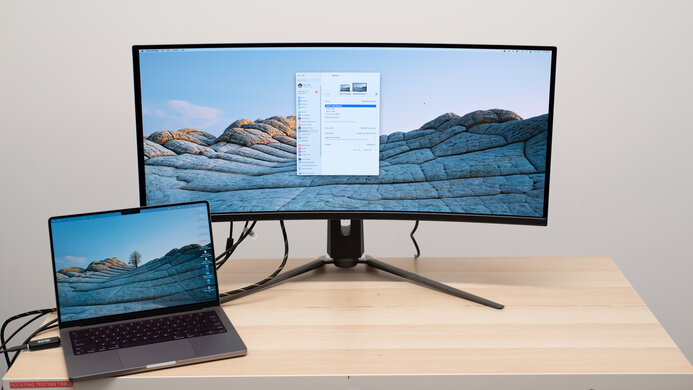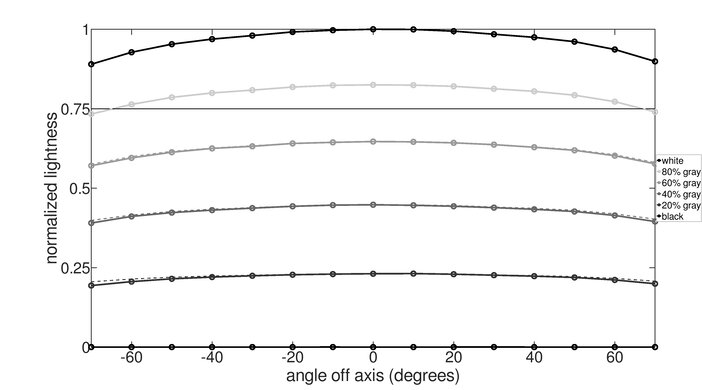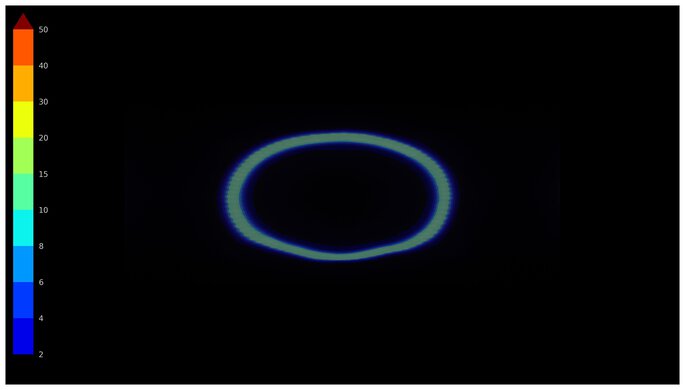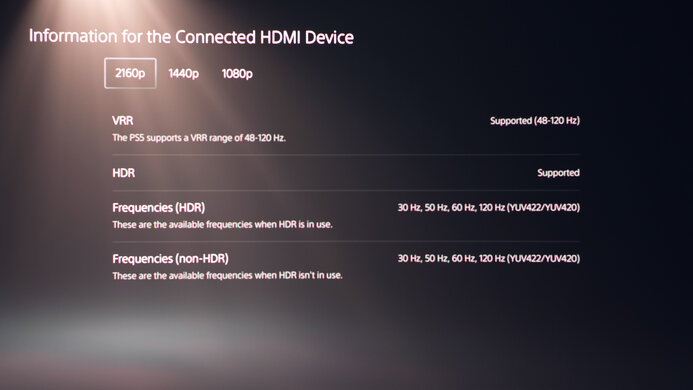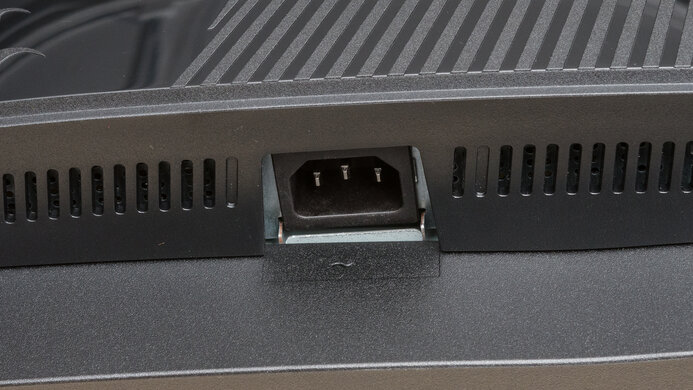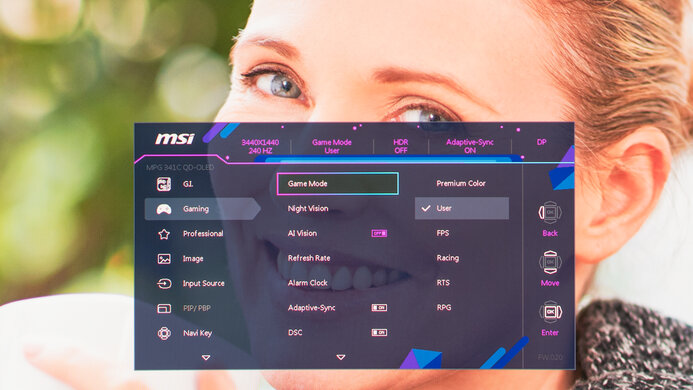The MSI MPG 341CQPX QD-OLED is a 34-inch 1440p ultrawide gaming monitor with a QD-OLED panel. It competes against other ultrawide OLED monitors like the LG 34GS95QE-B and the Gigabyte AORUS MO34WQC2. It has a 240Hz refresh rate, VRR support, and HDMI 2.1 bandwidth that lets it take full advantage of gaming consoles and high-end graphics cards. On top of its gaming features, it also has extra perks designed for everyday use, like a USB-C port with DisplayPort Alt Mode support and 90W of power delivery, as well as a KVM switch. As it's an OLED display, it's prone to permanent burn-in when exposed to the same static elements over time. It includes some settings to mitigate the risk of burn-in and has a custom heatsink to dissipate heat without a fan.
Our Verdict
The MSI MPG 341CQPX is fantastic for PC gaming. It has a 240Hz refresh rate with VRR support, and motion looks incredibly smooth thanks to its near-instantaneous response time. Your inputs also feel responsive, as it has low input lag. Additionally, it's incredible for gaming in dark rooms as blacks look deep and inky, and bright colors are vivid. However, deep blacks look purple in brighter rooms, and it has distracting VRR flicker when frame rates change rapidly.
-
Sharp motion thanks to near-instantaneous response time.
-
Perfect black levels in dark rooms.
-
Supports all common VRR formats.
-
Highlights pop in HDR.
-
High 240Hz refresh rate.
-
Noticeable VRR flicker with changing frame rates.
-
Black levels rise in bright rooms.
The MSI MPG 341CQPX is fantastic for console gaming. It has HDMI 2.1 bandwidth and is fully compatible with the PS5 and the Xbox Series X|S, but the consoles don't support ultrawide gaming, so you'll see black bars on the sides. Because of its near-instantaneous response time, it delivers a very crisp image, and its low input lag creates a responsive feel. It also displays deep blacks in a dark room, so it's great if you're gaming in a darker environment. However, if you're in a brighter room, deep blacks look purple.
-
Sharp motion thanks to near-instantaneous response time.
-
Perfect black levels in dark rooms.
-
Supports all common VRR formats.
-
HDMI 2.1 bandwidth for console gaming.
-
Highlights pop in HDR.
-
Black levels rise in bright rooms.
The MSI MPG 341CQPX is decent for office use, but there are some limitations. Its large, wide screen makes it easy to open multiple windows next to each other. However, while it works well with a few lights around, it doesn't get bright enough to fight strong glare. Additionally, its subpixel layout makes text appear slightly less clear than some other 27-inch 1440p monitors. Also, OLEDs like this one are prone to burn-in with constant exposure to the same static elements over time.
-
Ultrawide 34-inch screen.
-
Decent reflection handling.
-
Extra productivity features, like a KVM switch.
-
Wide viewing angles.
-
Text has a bit of fringing.
-
Doesn't get very bright in SDR.
-
Risk of burn-in with static elements.
The MSI MPG 341CQPX is excellent for media creation, but it has some limitations. It displays a wide range of colors and has impressive accuracy before calibration. Its ultrawide screen allows you to view more of your work area at once, and its wide viewing angles are great if you need to share the screen with someone next to you. However, its curved display isn't ideal if you need to view straight lines, and text has a bit of color fringing. Another major downside is that it runs the risk of permanent burn-in when exposed to the same static elements over time, like if your editing programs are open all the time.
-
Ultrawide 34-inch screen.
-
Decent reflection handling.
-
Extra productivity features, like a KVM switch.
-
Wide viewing angles.
-
Impressive accuracy before calibration.
-
Text has a bit of fringing.
-
Doesn't get very bright in SDR.
-
Risk of burn-in with static elements.
-
Black levels rise in bright rooms.
The MSI MPG 341CQPX has okay brightness. It isn't bright enough to fight intense glare in well-lit rooms, but it makes highlights pop in HDR.
-
Highlights pop in HDR.
-
Doesn't get very bright in SDR.
The MSI MPG 341CQPX has a near-instantaneous response time, leading to exceptionally sharp motion.
-
Sharp motion thanks to near-instantaneous response time.
-
Outstanding refresh rate compliance.
The MSI MPG 341CQPX is outstanding for HDR. It displays deep blacks in dark rooms, and there isn't any blooming around bright objects either. Its QD-OLED panel also displays a wide range of colors, making them bright and vivid.
-
Perfect black levels in dark rooms.
-
Displays wide range of vivid colors.
The MSI MPG 341CQPX has outstanding SDR picture quality, displaying deep and inky blacks in dark rooms and a wide range of colors.
-
Perfect black levels in dark rooms.
-
Displays wide range of vivid colors.
The MSI MPG 341CQPX has excellent color accuracy. It has impressive accuracy before calibration, but calibrating it still results in the best accuracy.
-
Impressive accuracy before calibration.
- 9.1 PC Gaming
- 9.1 Console Gaming
- 7.0 Office
- 8.8 Editing
Performance Usages
- 6.8 Brightness
- 9.9 Response Time
- 9.5 HDR Picture
- 10 SDR Picture
- 8.6 Color Accuracy
Changelog
-
Updated Jun 13, 2025:
We updated text throughout to match the new and updated tests with Test Bench 2.1, including in the Verdict section.
- Updated Jun 13, 2025: We've converted this review to Test Bench 2.1. This includes new tests for Direct Reflections, Ambient Black Level Raise, and Total Reflected Light. You can see all the changes in the changelog.
- Updated Feb 21, 2025: We've converted this review to Test Bench 2.0.1. This includes a new test result for DisplayPort 2.1 Transmission Bandwidth.
- Updated Nov 19, 2024: Review published.
- Updated Nov 13, 2024: Early access published.
Check Price
Differences Between Sizes And Variants
We tested the 34-inch MSI MPG 341CQPX. It's one of several monitors in MSI's lineup that features a QD-OLED panel, including the very similar MSI MEG 342C QD-OLED and the MSI MAG 341CQP QD-OLED. However, these monitors have a few differences, as you can see below. The results are only valid for this model.
| Model | Size | Resolution | Refresh Rate | USB-C Power |
|---|---|---|---|---|
| MPG 341CQPX | 34" | 1440p | 240Hz | 90W |
| MEG 342C | 34" | 1440p | 175Hz | 65W |
| MAG 341CQP | 34" | 1440p | 175Hz | 15W |
Our unit's label indicates that it was manufactured in July 2024. We tested it with firmware FW.020.
Compared To Other Monitors
The MSI MPG 341CQPX is a 34-inch gaming monitor with a 1440p resolution and 240Hz refresh rate. It's a newer monitor with a higher refresh rate than the MSI MEG 342C QD-OLED, and it competes against similar OLED monitors like the LG 34GS95QE-B and the Gigabyte AORUS MO34WQC2. Its 240Hz display is smoother than many previous-generation ultrawide OLEDs, and its QD-OLED display ensures bright colors are vivid. As a result, you don't need to choose between performance and image quality with this monitor. As the name indicates, ultrawide monitors are truly ultra-wide, and whether you prefer the extra width is a personal choice. If you prefer monitors with a more standard width, there are other high-refresh-rate QD-OLEDs with a 27- or 32-inch screen.
See our recommendations for the best ultrawide gaming monitors, the best gaming monitors, and the best 34-49 inch monitors.
The Dell Alienware AW3423DWF and the MSI MPG 341CQPX QD-OLED are 34-inch ultrawide QD-OLED gaming monitors. The MSI is the better choice for most people, as it has a higher refresh rate for smoother motion, HDMI 2.1 bandwidth, and USB-C connectivity with a KVM switch for productivity. However, the Dell is still an excellent monitor, and unless you need the MSI's higher refresh rate, it's a great option if you can find it for less.
The LG 34GS95QE-B and the MSI MPG 341CQPX QD-OLED are both 34-inch 240Hz OLED gaming monitors. The MSI is better if you want the most vivid colors. However, the LG is a better choice if you're gaming in a brighter room, as deep blacks don't have a purple tint in those conditions unlike the MSI.
The Dell Alienware AW3423DW and the MSI MPG 341CQPX QD-OLED are 34-inch ultrawide QD-OLED gaming monitors. You may prefer the Dell if G-SYNC Ultimate support is important to you, as only the Dell has it. However, the MSI is the better choice for most people, as it has a higher refresh rate for smoother motion, HDMI 2.1 bandwidth, and USB-C connectivity with a KVM switch for productivity.
The ASUS ROG Swift OLED PG34WCDM and the MSI MPG 341CQPX QD-OLED are 240Hz 34-inch ultrawide OLEDs. The ASUS is the better option if you're playing in a room with a lot of ambient light, as deep blacks don't appear purple. However, the MSI is the better option if you want the most vivid colors.
The Samsung Odyssey OLED G85SB S34BG85 and the MSI MPG 341CQPX QD-OLED are 34-inch QD-OLED ultrawide gaming monitors. For most people, the MSI is the better option, as it has a higher refresh rate for smoother motion, a KVM switch, and HDMI 2.1 bandwidth. That said, the Samsung is an excellent monitor, and if you can find it for less, it can be a great choice.
The MSI MEG 342C QD-OLED and the MSI MPG 341CQPX QD-OLED are 34-inch ultrawide QD-OLED gaming monitors. The 341CQPX is the better monitor for most people, as it has a higher refresh rate for smoother and more responsive gaming, and it gets brighter in HDR. However, if you don't need the higher refresh rate or slightly brighter highlights, the 342C has very similar performance and features and is a great value if you can find it for less.
Video
Test Results
The build quality is excellent. It feels solid, and the plastic body doesn't flex very much. However, the bottom of the screen curves up slightly, as you can see in the Vertical Viewing Angle video.
The ergonomics are decent, and they are particularly good for an ultrawide monitor. The stand has a cutout for cable management.
This monitor has a V-shaped stand that takes up a lot of space. The monitor wobbles a bit when bumped, but this is normal for an ultrawide monitor. The thickness is measured from the sides to the back of the stand, and the thickness from the center of the screen to the back of the stand is 8.7" (22.0 cm).
The thickness is measured from the sides to the back of the screen, and the thickness from the center of the screen is 3.2" (8.0 cm).
The MSI MPG 341CQPX has a near-infinite contrast ratio, as its QD-OLED panel can turn individual pixels on and off. This means it displays deep blacks next to bright highlights in dark rooms. However, in brighter environments deep blacks appear purple.
OLED panels like this one don't have a backlight, so they don't require a local dimming feature. However, with a near-infinite contrast ratio, there isn't any blooming around bright objects, and it's the equivalent of a perfect local dimming feature. We still film these videos on the monitor so you can see how the screen performs and compare it with a monitor that has local dimming.
Settings
- Pro Mode: User
- Game Mode: User
- Brightness: 100
- MSI OLED Care
- Pixel Shift: Slow
- Other OLED Care Settings: Off
The SDR brightness is adequate. It gets bright enough to fight glare in rooms with a few lights, though it can't overcome glare if bright light shines directly on the screen.
Settings
- DisplayHDR: Peak 1000 nits
- Brightness: Locked to max
- MSI OLED Care
- Pixel Shift: Slow
- Other MSI OLED Care Settings: Off
The HDR brightness is alright. It gets bright enough for small highlights to pop against the rest of the image. It also follows the PQ EOTF well enough, so it displays scenes at their correct brightness, but because it has a slow roll-off at the peak brightness, it doesn't let highlights get the brightest they can.
If you set DisplayHDR to 'TrueBlack 400' then there's less variation in brightness between scenes, but highlights also don't pop, as you can see below:
| Window Size | Peak | Sustained |
|---|---|---|
| 2% | 474 cd/m² | 469 cd/m² |
| 10% | 477 cd/m² | 470 cd/m² |
| 25% | 385 cd/m² | 380 cd/m² |
| 50% | 325 cd/m² | 323 cd/m² |
| 100% | 275 cd/m² | 274 cd/m² |
- EOTF: Chart
- Real Scene: 359 cd/m²
- ABL: 0.035
The MSI MPG 341CQPX has an incredible horizontal viewing angle. Although it technically isn't perfect, you visually won't see any inconsistencies when viewing from the sides or if you sit close to the screen.
The vertical viewing angle is fantastic. You won't notice any inconsistencies as you view the screen from the top or bottom.
The accuracy before calibration is great in the 'sRGB' Pro Mode with Game Mode set to 'User.' It locks colors fairly well to the sRGB color space, though they're a bit oversaturated. Additionally, its color temperature is close to the 6500K target, it has good white balance, and gamma is quite accurate, though very bright parts of scenes are a bit dark.
The 'sRGB' mode locks out the following settings:
- Contrast
- Low Blue Light
- Ambient RGB Light
- Color Temperature
If you want to access those settings, then you need to use another mode with worse color accuracy, as you can see in the graph for 'User' Pro Mode.
The accuracy after calibration is fantastic. Although it isn't perfect, like with gamma tracking, it improves the overall image accuracy.
The HDR color gamut is fantastic. It covers nearly all of the DCI-P3 color space used in most content, with minimal inaccuracies. However, it has a more limited coverage of the wider Rec. 2020 color space.
The HDR color volume is fantastic. It displays dark colors well and bright colors are vivid. These results are in 'Peak 1000 nits' mode.
Luminance levels for 'True Black 400'
- Red Luminance: 241 cd/m²
- Blue Luminance: 69 cd/m²
- Green Luminance: 716 cd/m²
The MSI MPG 341CQPX has decent text clarity, though it's not as good as some other non-OLED 27-inch 1440p monitors. This is because the monitor's triangular subpixel arrangement causes some color fringing around letters. Enabling Windows ClearType (top photo) improves the boldness of letters. These photos are in Windows 10, and you can also see them in Windows 11 with ClearType on and with ClearType off.
The direct reflection handling is decent. Reflections have a mirror-like effect, as light bounces off the screen, instead of spreading out. That said, because the screen isn't perfectly even, some bright objects look warped on the screen, but this depends on the light source itself and its positioning.
Ambient light causes the black levels to rise on this monitor, which is distracting if you have it in a bright room. This is typical of QD-OLEDs as they lack a polarizer. You need to use it in a dark room to get perfect black levels.
While you can reach the max refresh rate with a 1440p resolution over DisplayPort and HDMI, DisplayPort connections require Display Stream Compression (DSC) to do so. Most modern graphics cards support DSC. You can disable DSC on the monitor, but that lowers the refresh rate.
| NVIDIA | ||
|---|---|---|
| Connection | VRR Min | VRR Max |
| DisplayPort | <20Hz | 240Hz |
| HDMI | <20Hz | 240Hz |
| AMD | ||
|---|---|---|
| Connection | VRR Min | VRR Max |
| DisplayPort | <20Hz | 240Hz |
| HDMI | <20Hz | 240Hz |
In addition to FreeSync and G-SYNC compatibility, this monitor also supports HDMI Forum VRR.
| Frame Rate | CAD Heatmap | RT Chart | Pursuit Photo |
|---|---|---|---|
| 239 | Heatmap | Chart | Photo |
| 165 | Heatmap | Chart | Photo |
| 144 | Heatmap | Chart | Photo |
| 120 | Heatmap | Chart | Photo |
| 100 | Heatmap | Chart | Photo |
| 80 | Heatmap | Chart | Photo |
| 60 | Heatmap | Chart | Photo |
The MSI 341CQPX has outstanding motion handling across its entire refresh rate range with VRR enabled. CAD remains low throughout, and there's minimal blur with fast-moving objects.
The refresh rate compliance is outstanding. As it has a near-instantaneous response time, it makes full color transitions before drawing the next frame.
The monitor doesn't have an optional black frame insertion feature to reduce persistence blur further.
The MSI 341CQPX has low input lag with most refresh rates for a responsive feel. However, it increases a bit more than expected with fixed 60Hz signals, but this isn't an issue if you start gaming at a higher refresh rate and use VRR as the refresh rate drops.
There aren't any compatibility issues, and the monitor downscales 4k signals. However, you need to change the HDMI 2.1 setting to 'Console' for everything to work. Additionally, because the console doesn't support ultrawide signals, you'll see black bars on the sides unless you stretch the image.
This monitor works well with the Xbox Series X|S and downscales 4k signals. This is useful, as the Xbox only supports HDR with 4k signals. However, you need to change the HDMI 2.1 setting to 'Console' for everything to work. Additionally, because the console doesn't support ultrawide signals, you'll see black bars on the sides unless you stretch the image.
The DisplayPort Alt Mode on the USB-C port allows you to connect a compatible laptop to display an image from it and charge it at the same time with up to 90W of power.
| Connection | HDMI 2.0 | HDMI 2.1 | USB-C and DP |
|---|---|---|---|
| Max Refresh Rate | 100Hz | 240Hz | 240Hz |
| VRR Range | N/A | 48-240Hz | 48-240Hz |
| HDR | Yes | Yes | Yes |
The MSI MPG 341CQPX has no compatibility issues with macOS. If you're using a MacBook, windows move to the monitor's screen when you close the laptop's lid, and they return to their original position when you reopen it again over any type of connection. VRR and HDR both work well.
The KVM switch works well on macOS, and it switches effectively between PC and macOS after a 2–3 second switchover. If you put the macOS device to sleep when a PC is attached and turned on, the monitor switches to the PC.
The MSI MPG 341CQPX QD-OLED has extra features that improve the user experience. It has a KVM switch that makes it easy to switch between sources and use the same keyboard and mouse connected to the monitor. It works well and is responsive even if changing sources takes a couple of seconds. On top of the KVM switch, it has Picture-in-Picture and Picture-by-Picture modes to view two images at the same time, and it has different settings for how you can display the images.
MSI OLED Care
As with other OLED panels, it has a few settings to mitigate the risk of permanent burn-in when exposed to the same static elements over time.
- Pixel Shift: This moves the image by a few pixels at a time so that each pixel isn't always displaying the same thing. You can set it to 'Slow,' 'Normal,' or 'Fast,' so while you can't turn it off, it's very hard to notice it's happening with it set to 'Slow.'
- Static Screen Detection: Reduces the brightness of static elements, like logos, that have been on the screen for a long time.
- Panel Protect: Does a pixel refresh cycle to reduce the risk of permanent burn-in. You can run it manually anytime, though it will also run automatically when the monitor turns off after four hours of use. Additionally, a message pops up every four hours of usage to run the cycle unless you set Protect Notice to 'Usage 16 hrs.'
- The monitor has several other features to reduce burn-in, such as Multi Logo Detection and Taskbar Detection, which reduce brightness for fixed objects on the screen. Additionally, Boundary Detection reduces the brightness of boundaries, such as vertical lines between windows.
Additional Features
The monitor has some other extra features, like:
- HDMI CEC: It supports the HDMI CEC standard, so it automatically turns on when you power up compatible devices like consoles.
- Smart Crosshair and Optix Scope: These are two different settings for various crosshairs and scope features, making it easier to see opponents in games. Your games' anti-cheating tools won't detect it, giving you a competitive advantage.
Comments
MSI MPG 341CQPX QD-OLED: Main Discussion
Let us know why you want us to review the product here, or encourage others to vote for this product.
- 21010
Hi, thanks for reaching out! The strange brightness behavior with the Peak 1000 Nits HDR mode is a well known issue with this monitor. We updated the firmware to the newest version (FW.029) and can confirm that it is still not fixed. Some users online have solved this issue by downgraded their firmware to FW.020 so it could be worth a try.
Thanks for advice. I immediately returned it back to fw0.20.
- 21010
Hello, with the new firmware the monitor behaves strangely. Scaler - Firmware FW.025 Changes brightness like a mobile phone. (icc profile - rtinsg, in windows hdr on, peak 1000)
Hi, thanks for reaching out! The strange brightness behavior with the Peak 1000 Nits HDR mode is a well known issue with this monitor. We updated the firmware to the newest version (FW.029) and can confirm that it is still not fixed. Some users online have solved this issue by downgraded their firmware to FW.020 so it could be worth a try.
- 21010
Hello, with the new firmware the monitor behaves strangely. Scaler - Firmware FW.025 Changes brightness like a mobile phone. (icc profile - rtinsg, in windows hdr on, peak 1000)
Edited 1 month ago: forgot add description Update: We updated text throughout to match the new and updated tests with Test Bench 2.1, including in the Verdict section.
- 32120
Any rumours when we may expect updated Dell Alienware with bumped freq to 240Hz to compete with this screen…?








